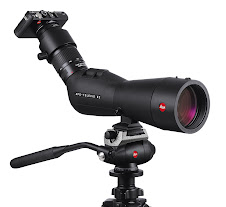

If not centered properly, the vignette will disappear from one edge but not the opposite (as above) or perhaps from all but one corner of the image as you increase scope zoom. This is a clear indicator that your camera is off center. In the example shown above, the camera is a bit too far to the right and needs to be adjusted slightly to the left for best results. Remember, that the circle we are working with is less than 4 mm wide so adjustments will be slight. These seemingly small differences will become even more problematic as you increase the scope zoom because the small circle of light leaving the eyepiece (exit pupil) may be reduced from 1/2 to 1/3 its original size when you increase the scope zoom.
With our 2 dimensional adjustments made on the flat plane from side to side, up & down, and on the diagonals, we now need to turn our attention to getting the proper distance between the camera lens and the scope eyepiece.

old style, generic universal digiscoping adapter
This last adjustment seems to be the one most commonly ignored or missed in many digiscoping set ups resulting in ruined photos and great frustration. In many older, well established digiscoping websites, you may find this is largely ignored, not mentioned, or may seem unnecessary or not understood by many long time digiscopers due to inherent biases of certain types of formerly popular adapters.
The sample universal adapter above is fairly typical of most early adapters that utilized filter-thread (accessory) rings on the front of the p&s cameras as a means of attachment between the camera and adapter. Unfortunately, there are almost no current p&s models that still offer accessory threads because these units are replaced so frequently that accessories really don't seem to sell. It seems each year there maybe 2 in a field of hundreds of new digital p&s cameras that both lend themselves to digiscoping and offer filter thread rings at the front of the lens. These adapters are extremely limited as a result.
Another issue with these adapters is that due to the metal rings and adapter rings present between the two lenses these adapters almost invariably meant you could never get the two lenses too close together. As a result, many sites erringly suggest you always need to get the lenses as close as possible together for best results.

blackened, semicircular arcs appear when lenses are too close together
If you get your eye too close to a binocular lens you will get "black out" sections in your view that appear as shadowed arcs near one side of the image as seen in the image above. You don't have to take my word for it, try it for yourself. twist or roll down the eyecups on your binoculars and remove your glasses if you wear them and get the binocular eyepieces as close as possible to your eyes. You should note an effect similar to what is shown above.
Well not surprisingly, the effect is the same when coupling two lenses afocally (that is mounting a camera with a lens behind an eyepiece in this case). If the two lenses are too close together, you need to draw these apart until you see a more uniform colored background. This is particularly noticeable on light backgrounds like the sky.
 when lenses are too far apart you'll note darkened corners
when lenses are too far apart you'll note darkened corners
In the image above I've purposely pulled the lenses too far apart. If you experiment with your eye and a binocular or scope you can actually predict what happens in digiscoping as the systems really aren't too terribly different. When you move your eye away from the lens, your field of view collapses leaving just a small circle of light visible. You can see this happening in the image above as well. As the lenses are drawn apart the field begins to collapse and you begin to see shadowing at each corner of your image.
Note the difference in the terms "shadowing/shadowed edge" versus "vignetting/vignetted edge", I differentiate between these two as they indicate a different problem. As I define these terms "shadowed edges" have a bit of opacity to them - that is you can see through them a bit. A "vignetted edge" is sharply defined and completely black with no opacity.
A sharply defined blackened edge or vignette indicates you are off center or simply need to run your zoom out more. Shadowed edges generally indicate the two lenses are too far apart and need to be moved closer together. Shadowed arcs that are in the interior of the frame will have a lighter section between the shadow and the edge. When seen you should move the two lenses a bit further apart.
Not the most interesting subject I realize but to save time, I just zipped out the back door and took some sample shots of my storage shed. The light doors provided a good background to show shadowing. When the lenses are adjusted properly the field should look uniform and be devoid of shadowing & vignetting.
As I travel the country and beyond teaching digiscoping classes, I find that coupling errors are responsible for a majority of common digiscoping image problems/failures. Hopefully some will find this information helpful. As always, if there are ever any questions feel free to ask in the comments section. I'll happily address all to the best of my ability.
J





















































